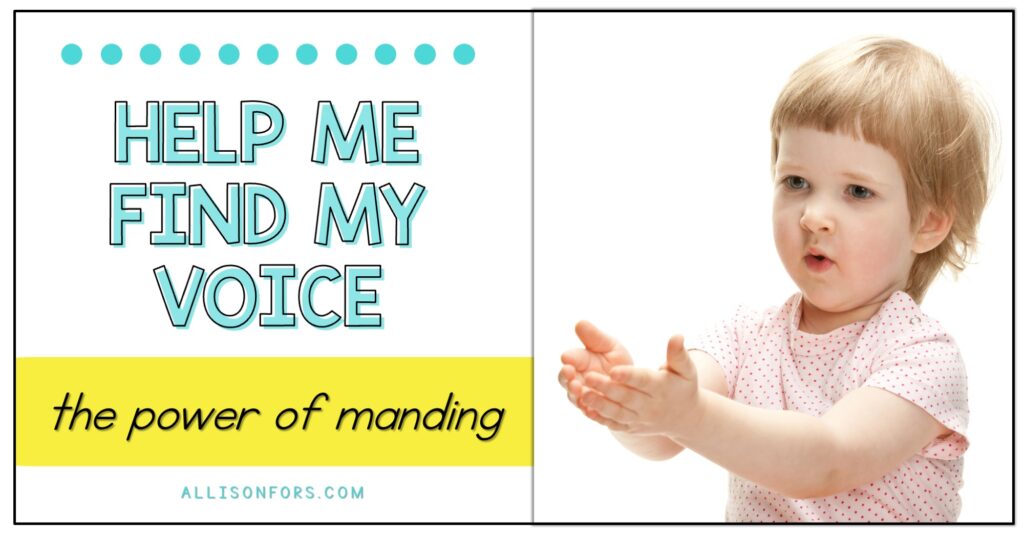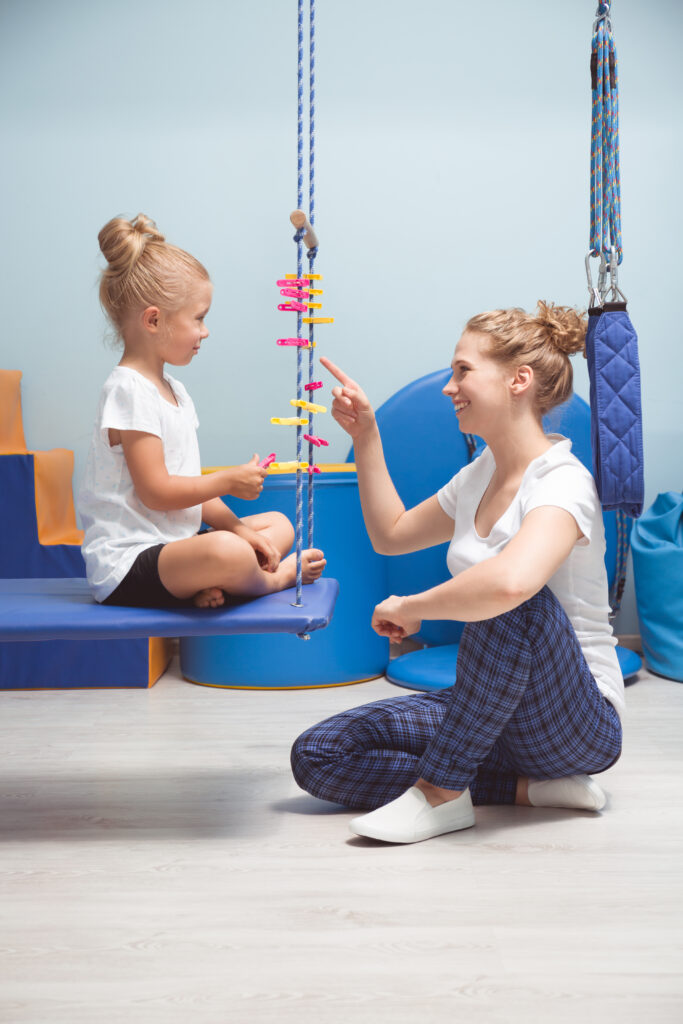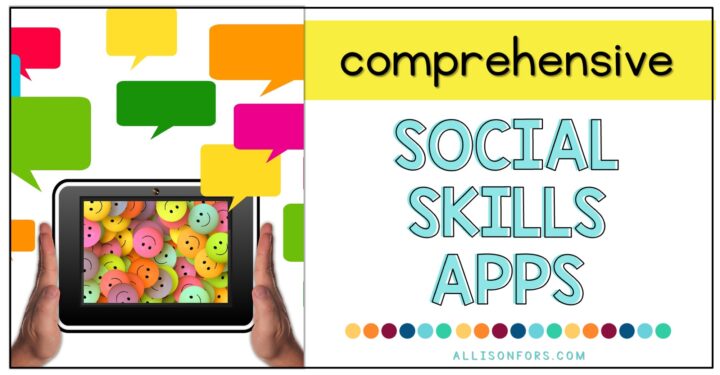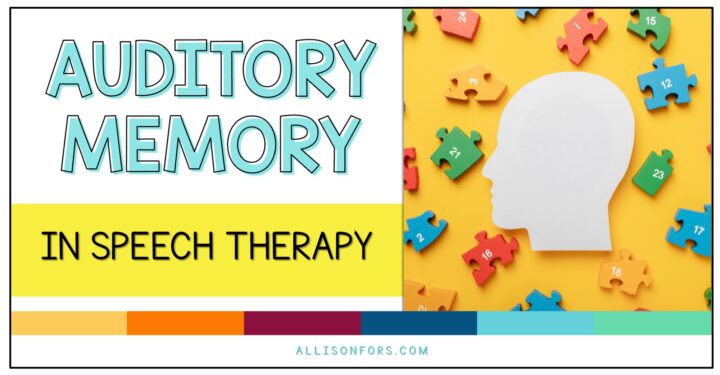
Help me Find my Voice: The Power of Manding

Welcome and thanks to my guest blogger, Rose from ABA Speech!
Do you have students on your caseload who are non verbal or limited verbally? Sometimes it can be very overwhelming to know where to start with students who are just developing a way to communicate with the world. When I encounter a student at this language level, I assess their ability to mand or request wanted items or activities. Often times, manding is not evaluated as it is usually not included in a majority of the standardized tests that are out on the market today.
You may be asking “why would we start work with manding?” Manding is the only verbal behavior that immediately benefits the speaker: I say something, I get something. The gold standard is for a student to be initiating; to say, “I want to play the game. I want to see the trains,” rather than waiting to be asked “What do you want?”
Some students – particularly, in my experience, those with autism – are very prompt- dependent. Manding helps teach them that they can be initiators. By making sure that our direct instruction has a targeted focus on manding, we allow for our students to increase their spontaneous communication: a student learns that when they want to take a walk, they can ask to “take a walk” and immediately go for a walk. This simple direct teaching model, incorporating a student’s favorite things, actions, etc., helps our students increase their expressive language skills.
Below are 3 strategies to keep in mind when you are working on manding with a student.
Strategy 1: Prompt mands initially to teach the child that it’s easy to get things with verbal behavior, so as to not turn the child off to communicating.
This is such an important piece of advice. We need to use prompts so that our children realize that communication is not a laborious process – it is something that gets them what they want and need.
We need to help them learn “I do – I get.” So if they mand for bubbles with assistance, they get bubbles – the verbal message does not have to be perfect. In time, with direct and effective instruction, we will get there! If they want to jump on the trampoline, we help prompt them to communicate this at the level they are at, and then we jump.
Prompts are our way to help teach learners new skills. We provide prompts at first to show that we are there to help and then systematically fade out this prompting as the student becomes more independent with the skill.

Strategy 2: Always start work with the student requesting their most powerful reinforcers.
We want to make sure that the student is motivated and very excited about the items or actions that we are helping them to request. For example, if we have a student who really loves dancing to music, we could work on requesting “music” or “dance.” If we have a student who really loves being outside, we could have them work on requesting outside.
Working on 5 mands initially is a general rule of thumb. We want to make sure that we work on a variety of mands so that the learner does not overgeneralize one mand. This means we do not want to teach just one mand, because the learner may try to use this one mand to ask for a variety of actions and/or items. We instead want to analyze their strongest reinforcers and start with teaching them to mand for at least 5 of those actions and/or items.
Manding for these preferred things teaches the learner that their communication is powerful. We are setting the groundwork so that they will learn that when they ask for something they will get it: “I do (request) – I get”. We do not want the learner to request items or actions that they are not interested in. (If you have a learner who is very limited in what they are interested in, please see the section above on preference assessments.)

Strategy 3: Always teach specific mands.
We want to make sure that the mands that we are teaching are specific in nature. Examples of specific mands would include cookie, movie, walk, jump and music. Examples of general mands and mands that we do not teach first include more, please, thank you and bathroom.
We do not teach more, please, thank you and bathroom first! This is a very important point. These mands can be taught but much later, when a learner has many independent mands (at least 50).
Here is why: if we pick 5 initial mands to teach and the learner is using them independently, we have broadened their vocabulary repertoire by 5 words. If we do not follow this pointer, and instead teach “more,” the student will only use the word more to mand for a variety of things – they will only have 1 mand.
Likewise, if a student mands for more, the instructor may need to ask “more of what?” This goes back to our point that a mand should stand alone. If a student mands for music, we don’t need to ask “what music” – they conveyed their specific message. If a student sees bubbles and says “blow bubbles,” we know exactly what they want, because the mand was specific. If a student stands in their classroom and says “more,” the message is not conveyed as we may not know what they want more of.
No matter your student’s age, if they are limited verbally direct instruction with manding is essential. Helping others find their voice is such hard and rewarding work. I hope that when you encounter a student at this language level that you will work directly on manding.
Rosemarie Griffin is a speech language pathologist, board certified behavior analyst and product developer. She is the creator of the Action Builder Cards. To learn more about this manding or to gather information about using applied behavior analysis to help students increase their communication skills, check out her website www.abaspeech.org or like her facebook page here: ABA SPEECH ON FACEBOOK.
Are you interested in being a guest blogger? Fill out this form!






